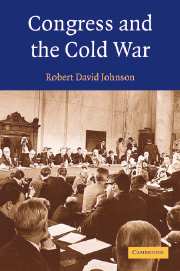Book contents
- Frontmatter
- Contents
- Abbreviations Used in the Text
- Acknowledgments
- Prologue
- Archives Consulted
- Congress and the Cold War
- 1 Constructing a Bipartisan Foreign Policy
- 2 Legislative Power and the Congressional Right
- 3 Redefining Congressional Power
- 4 The Consequences of Vietnam
- 5 The Transformation of Stuart Symington
- 6 The New Internationalists' Congress
- 7 The Triumph of the Armed Services Committee
- Appendix A The Foreign Aid Revolt of 1963
- Appendix B The Senate and U.S. Involvement in Southeast Asia, 1970–1974
- Appendix C The Senate of the New Internationalists, 1973–1976
- Appendix D The House and the End of the Cold War, 1980–1985
- Index
Prologue
Published online by Cambridge University Press: 05 June 2012
- Frontmatter
- Contents
- Abbreviations Used in the Text
- Acknowledgments
- Prologue
- Archives Consulted
- Congress and the Cold War
- 1 Constructing a Bipartisan Foreign Policy
- 2 Legislative Power and the Congressional Right
- 3 Redefining Congressional Power
- 4 The Consequences of Vietnam
- 5 The Transformation of Stuart Symington
- 6 The New Internationalists' Congress
- 7 The Triumph of the Armed Services Committee
- Appendix A The Foreign Aid Revolt of 1963
- Appendix B The Senate and U.S. Involvement in Southeast Asia, 1970–1974
- Appendix C The Senate of the New Internationalists, 1973–1976
- Appendix D The House and the End of the Cold War, 1980–1985
- Index
Summary
Diego Garcia attracted widespread national attention in 1991, when it served as the only U.S. Navy base from which offensive air operations were launched during Operation Desert Storm. Located 1,000 miles southwest of India, the 17-square-mile atoll described by Time as “one of those incongruous specks on the map that once posted the British Empire” passed under U.S. lease in 1966. The island provided strategically placed access to the Indian subcontinent, Central Asia, and the Middle East. After the Iranian Revolution in 1979, Diego Garcia experienced the most dramatic buildup of any U.S. overseas military installation since the Vietnam War, culminating in completion of a $500 million construction project a few years before the Iraqi invasion of Kuwait.
The Gulf War did not represent the first time in which Diego Garcia's fate intersected with momentous national events. In early 1974, ignoring formal protests from the governments of India, New Zealand, Australia, and Sri Lanka, the Navy requested $29 million to expand what was then a limited communications facility into the beginnings of a full-fledged military base. “In terms of political implications and potential for troublemaking,” the Baltimore Sun noted at the time, “Diego Garcia has dimensions that warrant a full-scale congressional study.”
- Type
- Chapter
- Information
- Congress and the Cold War , pp. xiii - xxviPublisher: Cambridge University PressPrint publication year: 2005



